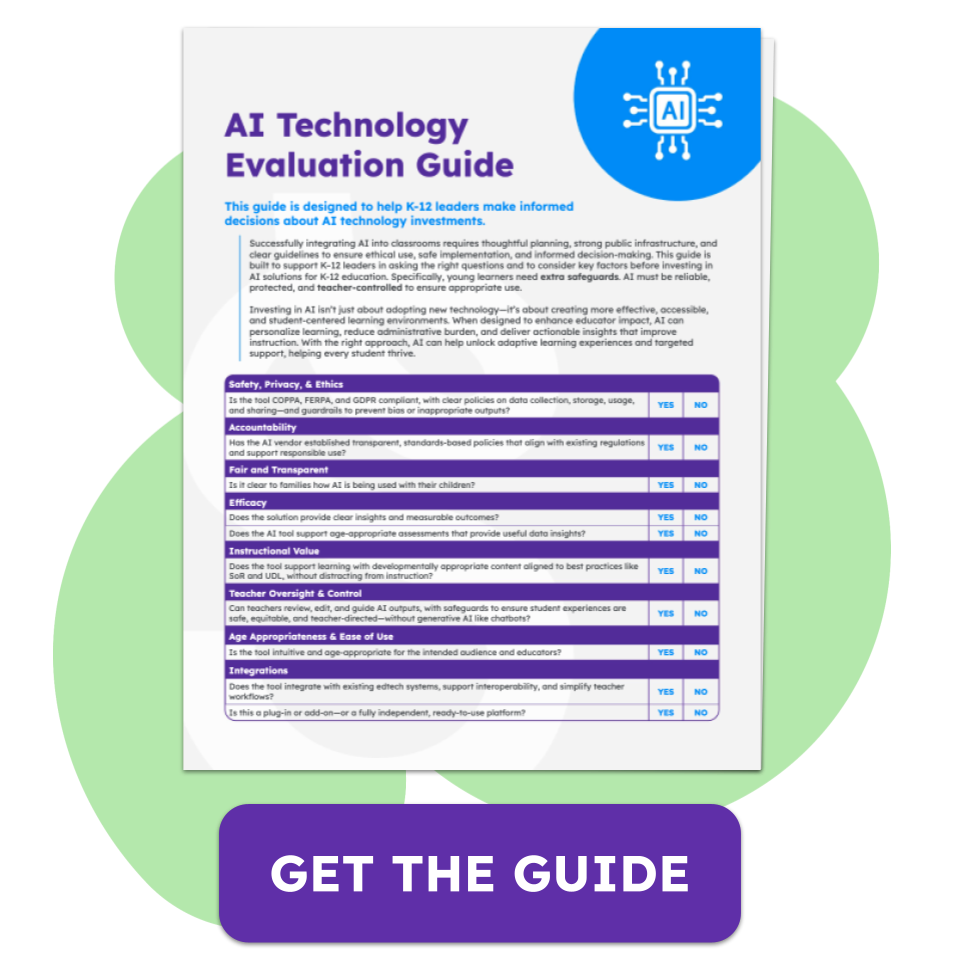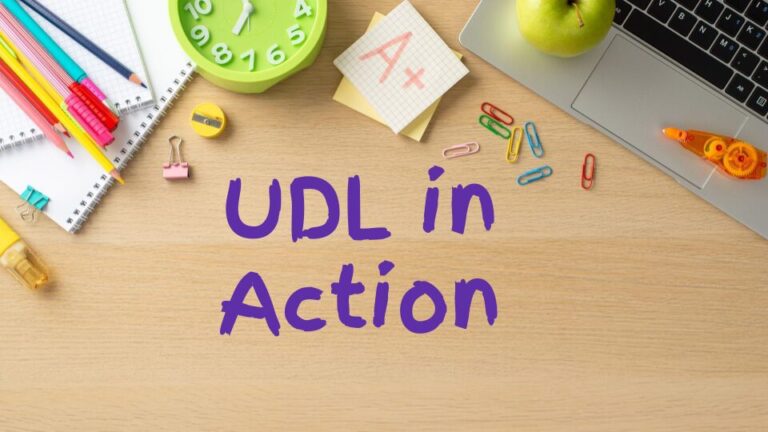There’s a lot of hype around AI for educators today. New AI-based solutions are popping up daily around the world with lofty promises. Understanding what AI-based solutions for elementary teachers can (and cannot) do is the first step in finding tangible value with AI in classrooms.
This blog will share perspective into what AI in the K-5 classroom can look like and some common pitfalls to look out for. Selecting AI-based solutions for teachers is an important step, and one that should be taken with the proper knowledge and instructional goals in mind. This blog is your first source for that foundational knowledge.
The fundamentals of AI for educators
Defining what AI in education for K-5 teachers is and how it works is the first step in adoption. Artificial intelligence (AI) refers to computer systems that can perform tasks (recognizing patterns, generating content, or making recommendations).
Although these tasks help teachers, not all AI educational solutions are created equal. Things to know about AI for educators:
- AI is trained. Algorithms rely on data for training, which helps them identify patterns and respond to user inputs with new outputs based on its training data. The more data it has, the better it can recognize patterns. Training data can also bias outputs, as the data it is trained on may have biases or gaps that we, as educators, cannot see
- AI doesn’t think. It is a computer program. It cannot feel emotions, read context that we can see and feel, and nuance the content like humans can. It makes data informed predictions based on its training data, and not on values or judgement
- AI is evolving. Our view of AI today is just what we see right now. AI is changing and may look different in a year. It is important to stay curious, but skeptical about these solutions
- AI should support, not replace, teachers. At its best, AI-based solutions for teachers streamline workflows and enhance instruction. But they are not a replacement for your professional expertise, emotional insight, or connection to students
Realistic application of AI educational solutions in K-5 classrooms
The most important question to ask before using an AI educational tool for elementary classrooms is: Why am I using this in the first place?
Using any new tool, including AI in classrooms, because it is “new and shiny” is never a best practice. If classrooms take this model with an AI (or any) edtech tool, there can be negative consequences for students. Here are some realistic examples of how AI-based solutions can easily – and safely – benefit teachers:
- Automate Administrative tasks: Lesson planning, simple grading tasks, generating communication blurbs
- Personalized Learning: Adapting content to fit the needs of a specific group of students, building assessments to measure multiple levels of learning, recommending content based on levels
- Accessibility support: Assistive technology like screen readers, language supports built into learning experiences
Pitfalls to avoid with AI educational solutions
While the right AI-based solutions for teachers can help, just having “more AI” in classrooms will not always be helpful or even safe. Here are key pitfalls to consider:
Over-reliance on AI-based solutions
One of the most common things said about AI is that it will replace teachers. This is actually the opposite of how AI educational solutions should be leveraged. Relying fully on AI tools for K-5 classrooms removes the critical judgement lens that humans bring. Teachers need to pay close attention and review any grading done by AI to avoid potential bias in grading. One example is tone of voice, AI may mark down for certain words or writing styles due to a lack of cultural understanding. Teachers need to remain in the loop as they know their students best and can bring that background knowledge to the grading process.
Loose privacy and data security standards
AI solutions rely on data and information to train their models. When students are directly interacting with AI educational solutions, they are feeding in the information used to train. It is imperative that purchasers thoroughly understand how each AI tool uses data and information not only from registration, but how it is used to train models. Companies should be transparent about their policies and disclose this information to users.
Accuracy, or lack thereof
AI-based solutions are only as accurate as the data they’re trained on, and they can produce inaccurate or incorrect information even when trained on reliable sources. As we know from digital literacy best practices, we want our students to vet and cite reliable sources. This is often challenging with AI outputs. They often pour out old or misinformation. This can be information you use to teach your entire classroom, or even worse, things that you give a struggling student to help them catch up. Relying on AI educational solutions can help streamline your classroom, but be mindful that AI is not a source of truth – everything generated should be checked before handing it out to students.
 Make decisions on AI for educators with the right information
Make decisions on AI for educators with the right information
Before embedding any AI solutions for elementary teachers, evaluate if it is safe and ready for a K-5 classroom. This not only answers the foundational question “Does it provide equitable and measurable growth for all students?” but it aligns with industry initiatives such as the Science of Reading.
Vendors make promises to educators with lofty marketing claims and revolutionary growth without providing evidence. Look for 3rd party efficacy results and recognition from reputable educational organizations to separate proven tools from the marketing fluff.
Beyond this, there are often vague privacy policies and one-size-fits-all all developmental tools. Before even considering an AI tool for your teachers, evaluate it. Does it meet the needs of your grade levels? Will it help enhance the experiences of your students? Using a framework like EDSAFE aligns your evaluation with COPPA and FERPA compliance and transparent data policies.
Final Thoughts on Utilizing AI for Educators
Integrating AI into K-5 classrooms can save you time, personalize learning, and remove access barriers, but only if the tools are chosen intentionally. Don’t be swayed by flashy marketing or vague claims.
Look for AI educational solutions that are specifically designed to meet the needs of K–5 learners, not generic platforms that try to serve all grades and subjects with a one-size-fits-all approach.




